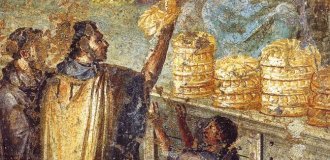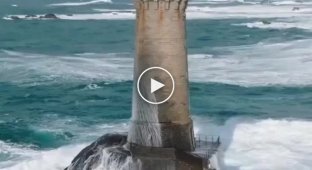The Tevennec Lighthouse - why is it considered a beacon of horror in France? (9 photos + 1 video)
Lighthouses are somewhat mystical structures in themselves. After all, their seemingly purely practical task - to help ships navigate at sea - is associated with a constant struggle with the elements and resistance to almighty waves. 
And this one - the Tévennec lighthouse - earned its eerie reputation for a reason. Very soon after its commissioning in 1875, the Tévennec lighthouse acquired a very bad reputation. Was it a cursed lighthouse, haunted by the ghosts of shipwrecked men, or a living hell for the lighthouse keepers who were said to have gone mad and died as a result? Rumours of France's most cursed lighthouse are still part of Breton folklore. 
Located in the 8km-long, turbulent Raz de Seine Strait on the western tip of France's Brittany region, the Tevennec Lighthouse has been the subject of much speculation since its construction.
They say that after the lighthouse was put into operation, everything fell into disrepair... The administration of Ponts et Chaussées initially assigned only one keeper to the lighthouse, since they had difficulty classifying the lighthouse among its fellows. And according to the classification of French sailors, it is neither "Hell" (a lighthouse on the open sea), nor "Purgatory" (a lighthouse on an island), and certainly not "Paradise" (a lighthouse on the coast). 
Since it does not fit the standards of these three types of lighthouses, it was decided to assign one keeper to it, like the "Paradise", on the sole grounds that the lighthouse lantern was... small. And this despite the fact that Tevennec is located in the very center of an inaccessible area and that it would undoubtedly benefit from having at least two keepers on duty all year round.
When it was built, strange stories began to multiply. The builders heard ominous cries, which were eventually translated as: "Kers kuit! Kers kuit! "Ama ma ma flag!" is a Breton phrase meaning "Go away! Go away! This is my place!" 
The first keeper, Henri Porsmoguer, lasted only five months before he resigned. It was said that he had gone mad from the wild howling that could be heard in the lighthouse on stormy days. It is believed that it was the Breton folklorist Anatole Le Braz who recorded his testimony in his work "The Keeper of the Flame" and intertwined it with the tragic story of a shipwrecked man who had found refuge on the rock a few years before the lighthouse was built. The turbulent currents prevented anyone from coming to his aid, and he suffered for four days and three nights before dying alone on the rock.
From then on, he would appear on the island as a ghost on stormy days, screaming when the waves became too rough. 
Charles Le Goff then published the dark legend of the cursed Tevennec lighthouse in his Les Phares series. It tells of a botched exorcism, of a lighthouse keeper who went mad when he thought he saw his father being pierced by a knife blade. The series also included stories of lighthouse keepers who died mysteriously or committed suicide, and of those who, in a fit of madness, attacked their own families. 
These rumors were supported by a serious writer, a leading member of the French Academy, and no one doubted the veracity of the horror stories, thanks to which Tevennec is now considered the most haunted lighthouse in France, from which keepers flee like the plague.
The lighthouse had such a bad reputation that in 1910 it became the first in France to be automated, since no one wanted to stay there anymore. 
Since then, the lighthouse no longer needed a keeper, but it has not lost its sinister reputation, which is still talked about by old sailors, who are sure that something strange is happening on the island.
It was only in the late 1990s that historian Jean-Christophe Fichou shed light on the reality behind the creepy stories about Tevennec. According to the archives of the city of Quimper, none of the keepers went mad or died mysteriously. The only keeper to die at the lighthouse was an alcoholic with, logically, poor health. 
In addition, the characteristic howl of Tevennec can be explained by the presence of an underwater grotto that runs right through the islet. When the waves run into it and the air comes out, the grotto makes ominous humming sounds, very similar to screams.
The story of Tevennec, it would seem, is not so frightening. But for lovers of otherworldly oddities, there is always the possibility that new mystical components will be discovered in this story. 






















